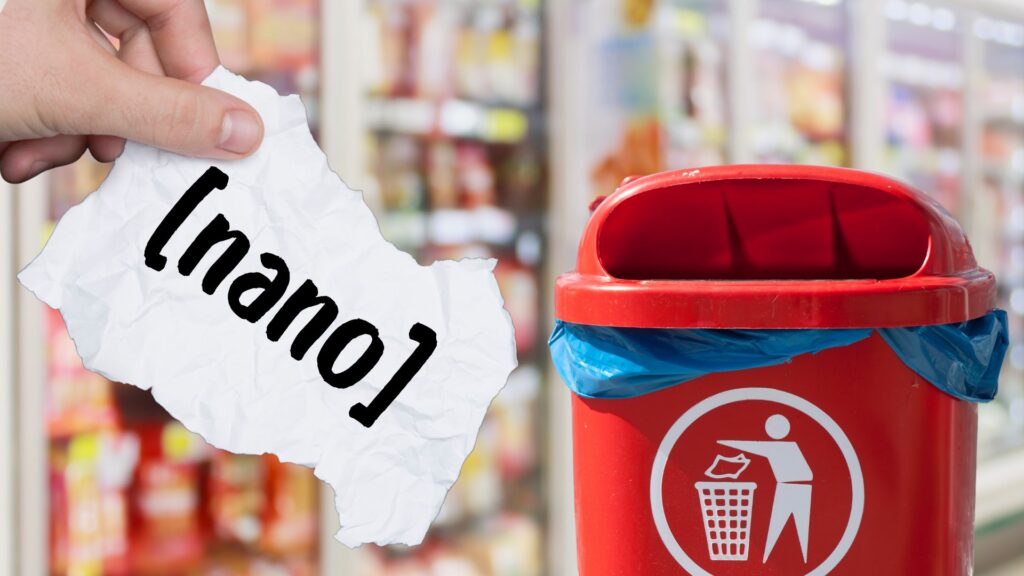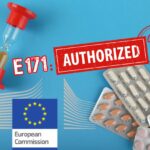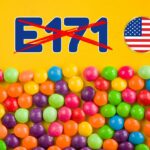
Will Europe torpedo the mandatory [nano] food label?
The European Commission has just unveiled its proposal for a new definition of the term ‘manufactured nanomaterial’ in European food legislation. Only four six weeks of consultation are planned for a topic that is highly technical and notably controversial – and was already rejected ten years ago due to its negative impacts on public health.
The Commission’s new draft definition…
A year and a half after publishing its disputed recommendation to define the term “nanomaterial” in 2022, the European Commission posted its draft delegated act on November 30 to incorporate this definition into its food legislation1 The Novel Foods Regulation n°2015/2283. A foursix-week consultation period will run until December 28, 2023 January 12, 20242AVICENN was informed of the two-week extension on December 12, open to all on the dedicated website https://ec.europa.eu/info/law/better-regulation/….
… bears a striking resemblance to the definition rejected ten years ago
This proposal is remarkably similar to the one proposed ten years ago, in December 2013. This earlier version faced fierce opposition from French authorities, and was also criticized by the European Federation of Consumer Associations (BEUC). It was finally rejected by the European Parliament in March 20143Defining nano-food: a big problem at a very small scale, European Parliament, 13 March 2014.
While there are some differences between the two delegated acts4The 2013 draft proposed using the 2011 definition recommendation, while the 2023 draft proposes using the 2022 recommendation—the shortcomings of both texts are strikingly similar. There is a significant risk that, in the end, almost no substance will be left to be considered, and consequently labeled, as a nanomaterial in food, despite the presence of numerous ingredients containing a significant nanoparticle fraction.
Why reintroduce a definition that Parliament rejected ten years ago? By doing this, the Commission’s disregards scientific advancements and knowledge since 2014, confirming that nanomaterials can cross physiological barriers and are often more hazardous than substances in micro or macro states.
Only ingredients containing more than 50% nano would be subject to [nano] labelling, compared with the current threshold of 10%
Among the contentious points, the Commission’s new project would exclude from the nanomaterial category in food:
- Non-solid particles micellar nanovectors (vesicles, liposomes, lipid particles, etc.)
- Nanostructured objects
- ingredients containing less than 50% of particles smaller than 100 nm
This last point led to the rejection of the Commission’s initial project as it would eliminate the [nano] labeling requirement for ingredients containing potentially dangerous nanoparticles, even with a 49% composition.
The current definition of manufactured nanomaterials in the Novel Foods Regulation5“Intentionally produced material having one or more dimensions of the order of 100 nm or less, or composed of distinct functional parts, either internal or on the surface, many of which have one or more dimensions of the order of 100 nm or less, including structures, agglomerates or aggregates which may have a size greater than 100 nm but which retain properties typical of the nano-scale. Typical properties of the nano-scale include:
i) properties related to the large specific surface of the materials considered; and/or
(ii) specific physicochemical properties that are different from those of the non-nano form of the same material.” and which the Commission proposes to replace with the 2022 definition recommendation, does not include a minimum threshold for particles below 100 nm.
Until now, French authorities have applied a 10% tolerance, which is much more protective for consumer information and health than the proposed 50% threshold. The latter would allow companies, for example, to use an ingredient composed of 49% particles below 100 nm without labeling it as [nano]…
An (illusory) response to the chemical industry’s demand
Why is is that a project which was deemed unacceptable in 2014 would be more acceptable today? “It’s about harmonizing terminology,” argues the Commission. Multiple different definitions of the term “nanomaterials” coexist, complicating the work of producers, importers, and sellers of chemicals. They complain about the difficulties in declaring “nanomaterials” defined differently in various national registers (like r-nano in France), in European REACH, and in sector-specific regulations (food, cosmetics, biocides, medical devices, etc.).
If suppliers provide precise and complete characterizations of substances and transmit information correctly to downstream businesses, they can apply the appropriate definition and regulation to their sector (food or otherwise).
More than the comfort of the chemical industry, it is the right to information and health safety that must prevail. If the Commission’s project were to be applied, neither consumers nor the agri-food industry would benefit.
Neither consumers nor the agri-food industry have any interest in this project being adopted
Should consumers’ right to information be sacrificed for the comfort of chemical companies?
Would this new definition solve the problems most frequently encountered by agri-food companies: incorrect attestations, improper characterization of substances, failures in information transmission between suppliers and brands, etc.? To both questions, a negative answer is self-evident.
On the contrary, both consumers and the agri-food industry6The case of iron oxides, used as colorants, is very interesting in this respect. While yellow iron oxides are generally more than 50% below the 100 nm mark, the nanoparticle fraction of red and black iron oxides may be less than or more than 50%, depending on the batch (Cf. Les nanomatériaux dans les produits destinés à l’alimentation, ANSES, mai 2020 and Scientific Opinion on the re-evaluation of iron oxides and hydroxides (E 172) as food additives, EFSA Panel on Food Additives and Nutrient Sources added to Food (ANS), décembre 2015). Would this make things easier for food companies? It’s doubtful… would have much to lose with the current project. The only potential winners would be the chemical industry and undoubtedly…. lawyers. The adoption of the project would introduce new terminological and metrological confusions : The French National Health and Safety Agency (ANSES) has already warned on several occasions of the pitfalls of the 2022 recommendation, notably in a very detailed report in April 2023 showing that this definition, not very robust from a strictly scientific point of view, would be very challenging to implement. If adopted, it would undoubtedly lead to lengthy disputes among experts and lawyers over the interpretation of terms and the application of the definition on a regulatory level. In short, a new headache for companies and regulatory authorities!
Last but not least, ANSES and AVICENN7See AVCENN’s report on 23 everyday products published in December 2022 (cf. pages n°25-26) consider that its implementation in sector-specific regulations (especially in food) would be detrimental to the prevention of health and environmental risks. And according to our information, French and Belgian authorities are also trying to counter the 50% threshold imposed by the European Commission.
Tests conducted by NGOs in France (Agir pour l’Environnement8Agir pour l’Environnement, ENQUÊTE EXCLUSIVE – Des analyses révèlent la présence de #nanoparticules dans des aliments!, 13 June 2016, 60 Millions de consommateurs960 Millions de consommateurs, Bonbons, gâteaux… Stop aux nanoparticules, n°529, Septembre 2017, Que Choisir10UFC Que Choisir, Nanoparticules dissimulées 9 plaintes de l’UFC-Que Choisir contre des fabricants de produits alimentaires et de cosmétiques, 23 January 2018, AVICENN11AVICENN Tests: most products with unlabeled or even unauthorized nanos, VeilleNanos, 15 December 2022), and abroad (in Germany12see particularly:
– Hintergrundpapier zu den BUND-Tests bei Wrigleys-Kaugummi und Jacobs-Cappuccino-Pulver, BUND (Friends of the Earth Germany), September 2018
– Presence of titanium dioxide in Dr. Oetker products in Germany, Foodwatch, August 2019, in Italy13Cf. Nanoparticelle di additivi negli alimenti. Chidiamo il bando dell’E171, Altroconsumo, May 2019, in Belgium 14Cf. “Nanomatériaux – Partout sans qu’on le sache”, Test Santé n°151, June 2019 and in Spain15Cf. “Comemos nanopartículas sin saberlo”, OCU-Compra Maestra n°449, July-August 2019) have repeatedly shown the presence of nanoparticles in food products. Let’s face it, even if a misleading definition would remove the [nano] labeling requirement for packaging of food products below 50%, it will not eliminate the nanoparticles detected under an electron microscope in the concerned products—nor the potentially associated risks.
AVICENN will respond to the consultation16Click here to read our feedback posted on January 12, 2024 and invites you to do the same. Feel free to share your questions, comments, or contributions in defense of the right to information and consumer protection.

Upcoming Nano Agenda

- Scientific conference
- 23rd International conference on Advanced Nanomaterials
- From July 23 to July 25, 2025
- Website: www.advanced-nanomaterials-conference.com

- E-learning program: awareness-raising for personnel who come into contact with nanomaterials during research, formulation, production, maintenance, cleaning, upkeep, etc., as well as safety coordinators or engineers, facility managers, heads of laboratories where nanoparticles are handled.
- Organizers: INSTN Grenoble (CEA)
- On the program:
- 1 – Introduction, definition and characteristics of nanomaterials
- 2 – Toxicity of nanomaterials: the state of knowledge
- 3 – Metrology and characterization of nanomaterials
- 4 – Prevention and protection against nanomaterials in the workplace
- 5 – Quiz: assessment of learning outcomes
- The 2-hour course can be viewed for one month from the date of registration.
- Website: https://instn.cea.fr/…risques-lies-aux-nanomateriaux…

- E-learning program: awareness-raising for personnel who come into contact with nanomaterials during research, formulation, production, maintenance, cleaning, upkeep, etc., as well as safety coordinators or engineers, facility managers, heads of laboratories where nanoparticles are handled.
- Organizers: INSTN Grenoble (CEA)
- On the program:
- 1 – Introduction, definition and characteristics of nanomaterials
- 2 – Toxicity of nanomaterials: the state of knowledge
- 3 – Metrology and characterization of nanomaterials
- 4 – Prevention and protection against nanomaterials in the workplace
- 5 – Quiz: assessment of learning outcomes
- The 2-hour course can be viewed for one month from the date of registration.
- Website: https://instn.cea.fr/…risques-lies-aux-nanomateriaux…
Notes and references
- 1The Novel Foods Regulation n°2015/2283
- 2AVICENN was informed of the two-week extension on December 12
- 3Defining nano-food: a big problem at a very small scale, European Parliament, 13 March 2014
- 4The 2013 draft proposed using the 2011 definition recommendation, while the 2023 draft proposes using the 2022 recommendation
- 5“Intentionally produced material having one or more dimensions of the order of 100 nm or less, or composed of distinct functional parts, either internal or on the surface, many of which have one or more dimensions of the order of 100 nm or less, including structures, agglomerates or aggregates which may have a size greater than 100 nm but which retain properties typical of the nano-scale. Typical properties of the nano-scale include:
i) properties related to the large specific surface of the materials considered; and/or
(ii) specific physicochemical properties that are different from those of the non-nano form of the same material.” - 6The case of iron oxides, used as colorants, is very interesting in this respect. While yellow iron oxides are generally more than 50% below the 100 nm mark, the nanoparticle fraction of red and black iron oxides may be less than or more than 50%, depending on the batch (Cf. Les nanomatériaux dans les produits destinés à l’alimentation, ANSES, mai 2020 and Scientific Opinion on the re-evaluation of iron oxides and hydroxides (E 172) as food additives, EFSA Panel on Food Additives and Nutrient Sources added to Food (ANS), décembre 2015). Would this make things easier for food companies? It’s doubtful…
- 7See AVCENN’s report on 23 everyday products published in December 2022 (cf. pages n°25-26)
- 8Agir pour l’Environnement, ENQUÊTE EXCLUSIVE – Des analyses révèlent la présence de #nanoparticules dans des aliments!, 13 June 2016
- 960 Millions de consommateurs, Bonbons, gâteaux… Stop aux nanoparticules, n°529, Septembre 2017
- 10UFC Que Choisir, Nanoparticules dissimulées 9 plaintes de l’UFC-Que Choisir contre des fabricants de produits alimentaires et de cosmétiques, 23 January 2018
- 11AVICENN Tests: most products with unlabeled or even unauthorized nanos, VeilleNanos, 15 December 2022
- 12see particularly:
– Hintergrundpapier zu den BUND-Tests bei Wrigleys-Kaugummi und Jacobs-Cappuccino-Pulver, BUND (Friends of the Earth Germany), September 2018
– Presence of titanium dioxide in Dr. Oetker products in Germany, Foodwatch, August 2019 - 13Cf. Nanoparticelle di additivi negli alimenti. Chidiamo il bando dell’E171, Altroconsumo, May 2019
- 14Cf. “Nanomatériaux – Partout sans qu’on le sache”, Test Santé n°151, June 2019
- 15Cf. “Comemos nanopartículas sin saberlo”, OCU-Compra Maestra n°449, July-August 2019
- 16Click here to read our feedback posted on January 12, 2024









